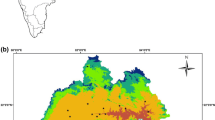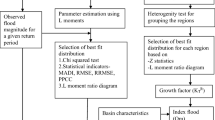Abstract
Best-fit distributions of floods in Tunisia are determined based on L-moment diagram and statistical tests. GEV and GLO distributions provided the best fit to seven and three regions of Tunisia respectively. In each homogeneous region, hierarchical approaches and regression models were developed for gauged and ungauged watersheds. The first two parameters of the distributions (GEV and GLO) were estimated from measured data while the third parameter was represented by the regional average value weighted by the record length of all stations in the region. The obtained parameters were correlated to the catchment size. Quantiles obtained by the proposed models were compared with those obtained using local conventional models. Statistical tests showed that the proposed models provided a much better agreement with observed floods than any of the conventional methods generally used in Tunisia.
Similar content being viewed by others
References
Abdul Karim M, Chowdhury JU (1995) A comparison of four distributions used in flood frequency analysis in Bangladesh. Hydrol Sci 40(1):55–66
Akaike H (1974) A new look at the statistical model identification. IEEE Trans Automat Contr AC-19(6):716–721
Alila Y (1999) A hierarchical approach for the regionalization of precipitation annual maxima in Canada. J Geophys Res 104(D24):31,645–31,655
Bobee B, Rasmussen PF (1994) Recent advances in flood-frequency analysis. American Geographical Union, 1111–1116
Cathcart JG (2001) The effects of scale and storm severity on the linearity of watershed response revealed through the regional L-moment analysis of annual peak flows. Ph.D. thesis, Institute of Resources and Environment, University of British Columbia, Canada
Chow V (1954) Statistical distributions used in flood frequency analysis. ASCE 136:218–225
Fiorentino M, Gabriele S, Rossi F, Versace P (1987) Hierarchical approach for regional flood-frequency analysis. In: Singh VP (ed) Regional flood-frequency analysis. pp 35–49, D. Reidel, Norwell, Mass
Frigui HL (1994) Formules Régionales d’Estimation des Débits Maxima de Projet en Tunisie. DGRE, Ministère de l’Agriculture, l’Environnement et les ressources en eau, Tunisie
Gumbel EJ (1958) Statistics of extremes. Columbia University Press, New York
Gupta VK, Mesa OJ, Dawdy DR (1994) Multiscaling theory of flood peaks: regional quantile analysis. Water Resour Res 30(12):3405–3421
Hazen A (1914) Storage to be provided in the impounding reservoirs for municipal water supply. Transactions; ASCE 77:1547–1550
Horton RE (1913) Supplemental note on frequency of recurrence of Hudson River floods. U.S. Weather Bureau Bulletin 2:109–112
Hosking JRM (1990) L-moments: analysis and estimation of distributions using linear combinations of order statistics. J R Stat Soc Ser B 52:105–124
Hosking JRM, Wallis JR (1987) Parameter and quantile estimation for the generalized Pareto distribution. Technometrics 29:339–349
Hosking JRM, Wallis JR (1988) The effect of inter-site dependence on regional flood frequency analysis. Water Resour Res 24:588–600
Hosking JRM, Wallis JR (1993) Some statistics useful in regional frequency analysis. Water Resour Res 29(2):271–281
Houghton JC (1978) Birth of a parent: the Wakeby distribution for modeling flood flows. Water Resour Res 14(6):1105–1109
IEG (Independent Evaluation Group) (2001) Tunisia – reduction flood hazards and traffic congestion: SFAX Flood Protection Project, World Bank
IH (Institute of Hydrology) (1999) United Kingdom flood estimation handbook. Institute of Hydrology, Wallingford, V 1(5)
Jenkinson AF (1955) The frequency distribution of the annual maximum (or minimum) values of meteorological events. Q J R Meteorol Soc 81:158–171
Jingyi Z, Hall MJ (2004) Regional flood frequency analysis for the Gan-Ming River basin in China. J Hydrol 296(1–4):98–117
Kallel R (1979) Evaluation des débits de crues maximas en Tunisie. DRE, Ministère de l’Agriculture, l’Environnement et les ressources en eau, Tunisie
Keeping ES (1966) Distribution-free methods in statistics, statistical methods in hydrology. Proceeding of Hydrology Symposium, No. 5, McGill University, Montreal, Canada
Matalas NC, Wallis JR (1973) Eureka! It fits a Pearson Type 3 distribution. Water Resour Res 9(2):281–289
Nathan RJ, Weinmann PE (1991) Application of at-site and regional flood frequency analysis. Proceedings of the International Hydrology and Water Resources Symposium, pp 769–774
Nguyen VTV (2006) On regional estimation of floods for ungaged sites. Asia Oceania Geosciences Society, McGill University, Singapore
Onoz B, Bayazit M (1995) Best fit distributions of largest available flood samples. J Hydro 167:195–208
Pearson CP (1991) New Zealand regional flood frequency analysis using L-moments. J Hydrol 30(2):53–63
Peel MC, Wang QJ, Vogel RM, McMahon TA (2001) The utility of L-moment ratio diagrams for selecting a regional probability distribution. Hydrol Sci 46(1):147–155
Pilon PJ, Adamowski K (1992) The value of regional information to flood frequency analysis using the method of L-moments. Can J Civ Eng 19:137–147
Pilon PJ, Harvey KD (1994) Consolidated frequency analysis package. Environment Canada, Ottawa, Ontario, Canada
Potter KW, Lettenmaier DP (1990) A comparison of regional flood frequency estimation methods using a re-sampling method. Water Resour Res 26(3):415–424
Rakesh K, Chandranath C (2006) Regional flood frequency analysis using L-moments for north Brahmaputra Region of India. J Hydrol Eng 11(4):380–382
Royston P (1991) Which measures of skewness and kurtosis are best? Stat Med 10:1–11
Vogel RM, Wilson I (1996) Probability distribution of annual maximum, mean, and minimum streamflows in the United States. J Hydrol Eng 1:69–76
Wallis JR (1989) Regional frequency studies using L-moments. Res Report R. C. 14597
Wallis JR (1988) Catastrophes, computing and containment: living with our restless habitat. Specul Sci Technol 11(4):295–324
Author information
Authors and Affiliations
Corresponding author
Rights and permissions
About this article
Cite this article
Ellouze, M., Abida, H. Regional Flood Frequency Analysis in Tunisia: Identification of Regional Distributions. Water Resour Manage 22, 943–957 (2008). https://doi.org/10.1007/s11269-007-9203-y
Received:
Accepted:
Published:
Issue Date:
DOI: https://doi.org/10.1007/s11269-007-9203-y




